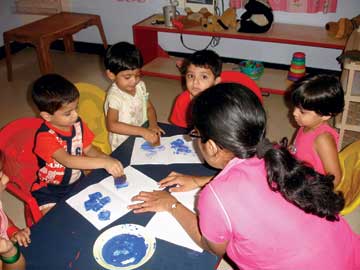Harini Kumar
 Eliminating mediocrity in education is a motto of EZ Vidya, an education solutions provider for schools. What is it that mainstream schools are not doing that would need supplementary efforts from such organizations? Founded ten years ago in Chennai with the mission “Let the child blossom”, EZ Vidya provides products and services to schools with respect to academic curricula, training of teachers and helping schools enhance their approach to education. Chitra Ravi, founder and CEO of EZ Vidya says that technology has played an important role in their interventions, through their products. While they share schools’ basic objective of imparting knowledge, organizations like EZ Vidya propagate a different approach to learning that many schools are now lapping up and reaping the benefits of.
Eliminating mediocrity in education is a motto of EZ Vidya, an education solutions provider for schools. What is it that mainstream schools are not doing that would need supplementary efforts from such organizations? Founded ten years ago in Chennai with the mission “Let the child blossom”, EZ Vidya provides products and services to schools with respect to academic curricula, training of teachers and helping schools enhance their approach to education. Chitra Ravi, founder and CEO of EZ Vidya says that technology has played an important role in their interventions, through their products. While they share schools’ basic objective of imparting knowledge, organizations like EZ Vidya propagate a different approach to learning that many schools are now lapping up and reaping the benefits of.
“We noticed that teachers are unable to get into the mind of the learner, and this is where we come in,” says Chitra Ravi. “Through an interactive and participatory approach that addresses the learning needs of today, our products motivate children to learn by providing multiple stimuli.”
EZ Vidya’s flagship product, Chrysalis – a complete information and communication technology (ICT) curriculum package that includes textbooks, workbooks and audio-visual material – offers what have come to be known as ‘21st century skills’. Schools that enroll with them replace their conventional materials with those provided by EZ Vidya, which ensures that there is a fit with the syllabus that the school follows.
 EZ Vidya also offers training for teachers in order to bridge the gap between education research and what is being imparted in schools. Curricula in mainstream Indian schools are often regarded as being heavy with content, weighing down students with concepts and definitions. Learning then becomes a weary, monotonous exercise that runs the risk of stunting a child’s personality growth. By using technology meaningfully, such products and services serve as a wake-up call to educators to improve their teaching methodology, question the basics, and offer a new curriculum while still adhering to the National Curriculum Framework (NCF) of 2005 and working within the guidelines laid out in national and state education policies. Through interactive workbooks, EZ Vidya seeks to trigger the thoughts of students by appealing to their different senses, giving them a chance to learn experientially rather than through a didactic method. For example, when a scientific phenomenon is explained through a poem to a student who likes poetry, it could create a more lasting impression than a simplistic definition that one usually sees in textbooks. Qualitative growth is emphasized over mere marks, which is perhaps why such products are being used widely in schools across the country.
EZ Vidya also offers training for teachers in order to bridge the gap between education research and what is being imparted in schools. Curricula in mainstream Indian schools are often regarded as being heavy with content, weighing down students with concepts and definitions. Learning then becomes a weary, monotonous exercise that runs the risk of stunting a child’s personality growth. By using technology meaningfully, such products and services serve as a wake-up call to educators to improve their teaching methodology, question the basics, and offer a new curriculum while still adhering to the National Curriculum Framework (NCF) of 2005 and working within the guidelines laid out in national and state education policies. Through interactive workbooks, EZ Vidya seeks to trigger the thoughts of students by appealing to their different senses, giving them a chance to learn experientially rather than through a didactic method. For example, when a scientific phenomenon is explained through a poem to a student who likes poetry, it could create a more lasting impression than a simplistic definition that one usually sees in textbooks. Qualitative growth is emphasized over mere marks, which is perhaps why such products are being used widely in schools across the country.
These products obviously come at a price, but surprisingly, it is not just private schools who can afford such material that opt for the change. By tying up with the Corporate Social Responsibility wings of many private and multinational companies, EZ Vidya is able to take its products to government schools as well.“Educators in both public and private schools have been extremely receptive to our products and the acceptance rate is a hundred per cent,” says Chitra Ravi. Teacher training and manuals as well as technology support ensures that the packages are well-rounded and meet the needs of the learners and the teachers alike. Much of their resources are pumped into research and development although efforts towards a more aggressive branding strategy are underway.
 iDiscoveri is another enterprise that works towards providing education solutions to schools, amongst their other offerings. The XSEED program is their mainstay, wherein the prerogative is to enhance and raise the performance of students as well as improve the quality of teaching. iDiscoveri was founded by an alumni of reputed institutions of higher education from around the world, such as Harvard, Cambridge, IIT and IIM. The XSEED experiential learning method is designed around five steps: aim, activity, analyze, apply and assess. The company notes that schools following the XSEED method have seen a marked improvement in teaching quality and student learning. The core of the XSEED program is the lesson plans or the curriculum manual which make use of the five-step teaching process. Teacher training and support is also offered to ensure that teachers are up to date with the program. The XSEED program also provides professional and comprehensive assessment and monitoring support for schools as well as parents to further their goal of holistic learning. iDiscoveri has spent hundreds of hours assessing teaching methods in classrooms to understand the changes required and to implement more experiential and real-life methods in teaching so that students understand concepts with clarity and in an interactive manner.
iDiscoveri is another enterprise that works towards providing education solutions to schools, amongst their other offerings. The XSEED program is their mainstay, wherein the prerogative is to enhance and raise the performance of students as well as improve the quality of teaching. iDiscoveri was founded by an alumni of reputed institutions of higher education from around the world, such as Harvard, Cambridge, IIT and IIM. The XSEED experiential learning method is designed around five steps: aim, activity, analyze, apply and assess. The company notes that schools following the XSEED method have seen a marked improvement in teaching quality and student learning. The core of the XSEED program is the lesson plans or the curriculum manual which make use of the five-step teaching process. Teacher training and support is also offered to ensure that teachers are up to date with the program. The XSEED program also provides professional and comprehensive assessment and monitoring support for schools as well as parents to further their goal of holistic learning. iDiscoveri has spent hundreds of hours assessing teaching methods in classrooms to understand the changes required and to implement more experiential and real-life methods in teaching so that students understand concepts with clarity and in an interactive manner.
 Everonn Education, Educomp Solutions and Nischal’s Smart Learning Solutions are some of the other enterprises that are offering educational products to enhance learning inside and outside the classroom. These interventions suggest that there is a change in the way parents, teachers and students alike are thinking about education and the future of the Indian school system. These products do not merely indicate the need to keep up with current trends globally and nationally but also point to the fact that the consumer – in this case, the parent – is demanding much more. Technology has made learning a continuous process that does not stop with the classroom, and there seems to be a demand for education that contributes to the intellectual as well as the emotional growth of a child. In such a scenario, the rapid proliferation of such education service providers who offer an array of different products comes as no surprise. Schools are also feeling the pressure of rising demands from parents and students for supplementary learning material or at many instances, a total revamping of existing teaching methods and tools.
Everonn Education, Educomp Solutions and Nischal’s Smart Learning Solutions are some of the other enterprises that are offering educational products to enhance learning inside and outside the classroom. These interventions suggest that there is a change in the way parents, teachers and students alike are thinking about education and the future of the Indian school system. These products do not merely indicate the need to keep up with current trends globally and nationally but also point to the fact that the consumer – in this case, the parent – is demanding much more. Technology has made learning a continuous process that does not stop with the classroom, and there seems to be a demand for education that contributes to the intellectual as well as the emotional growth of a child. In such a scenario, the rapid proliferation of such education service providers who offer an array of different products comes as no surprise. Schools are also feeling the pressure of rising demands from parents and students for supplementary learning material or at many instances, a total revamping of existing teaching methods and tools.
That there is need for ‘21st century skills’ is indicative of the changing times. However, with so many choices abounding, it can be confounding, especially for teachers of this generation, as they migrate to newer learning methods using technological tools that students are already familiar with in their everyday life. The pressure to perform in an increasingly competitive atmosphere does not affect only students. The onus is also on the teacher as she has to constantly keep up with current trends in education, use a variety of teaching strategies in the classroom and ensure that demands are met. And while the external inputs provided by such companies as iDiscoveri and EZ Vidya may complement those of the system, the mainstays of education will for a long time continue to be the school and the teacher.
The author is a freelance writer currently based in Chennai. She can be reached at harini747@gmail.com.
